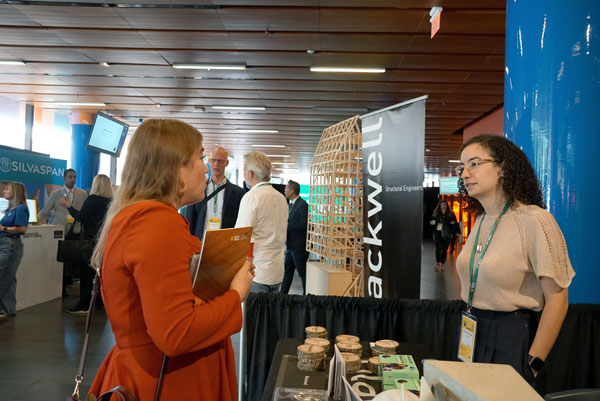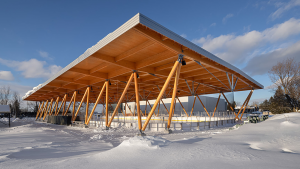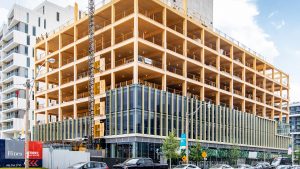As a $400 million a year industry mass timber is still in its infancy in Canada, representing only about one per cent of all construction.
Some analysts project the emerging market will hit $1.3 billion annually by 2030, but it will need to rapidly expand production capacity and overcome a number of logistical challenges to meet that projection.
Achieving a market share of five per cent of all construction and a 25 per cent share of the multi-family residential sector would be the definition of success for the team at WoodWorks, a program of the Canadian Wood Council, said Tim Buhler, technical manager of WoodWorks Ontario.
Buhler was the moderator of a panel session called Accelerating Mass Timber in Canada at Summit 2024 presented by WoodWorks at George Brown College’s Waterfront Campus in Toronto recently.
Panellist Steven Street said producers need to look at more circularity in their operations.
“They need to do more with their fibre, especially now that the (building) code is with us,” said the executive director of WoodWorks Ontario.
New code provisions that permit 12-storey mass timber housing provide opportunities for highrise builders to think about eight-storey unencapsulated residential designs, said Street.
“It’s really the game changer as far as we are concerned,” because these builders already have the know-how and resources to construct these buildings, he told a packed room.
Street added that Element5, which is in expansion mode, is proof that manufacturing can be successful.
“We need five more of them.”
In Alberta, where concrete and steel dominate construction, mass timber is primarily used for decking or roofing.
“We see it as part of the building solution, not the only solution,” said Rory Koska, program director for WoodWorks Alberta.
A public/private sector alliance would be a big step to the industry’s growth, he said, adding product standardization (billets) will further advance mass timber.

Koska said the Alberta government recently announced an $8.6 billion program to construct 90 new public schools by 2031 and it has shown interest in evaluating mass timber for schools.
“It could be a foot in the door where we would start to see buy-in,” he said.
Mass timber is growing in the institutional sector in Quebec largely because the provincial government requires that partly or wholly financed public institutional projects evaluate mass timber design options, says Simon Bellavance, technical adviser with Cecobois.
“It leads to a lot of schools and sports facilities in wood.”
There has been “a lot of pickup” in mass timber in the institutional sector in B.C. as well, partly because projects under an ESG framework pursuing provincial funding must include a mass timber option, said Shawn Keyes, executive director of WoodWorks BC.
Keyes added the City of Vancouver recently created density bonuses for mass timber in the private sector, offering two additional storeys for buildings eight to 12 storeys and three extra floors for projects over 12-storeys.
“It helps offset potential high costs,” he said, noting government support of mass timber and wood construction is “extremely strong” in B.C.
David Porter, program co-ordinator with WoodWorks Atlantic, said while nail laminated timber projects have been the standard in New Brunswick and Nova Scotia, that will change because construction will start next spring on a $250 million plant to produce 50,000 cubic metres of CLT annually and another plant is planning to roll out panels by 2026.
Street said while many municipal governments in Ontario don’t promote mass timber, there is a means for the sector to grow there because it meets net-zero targets set by many municipalities.
“If you set the right policy, wood will meet it.”
Scott Jackson, director of conservation biology at the Forest Products Association of Canada, told the audience the three main reasons to promote mass timber construction is it fits with net-zero targets, helps address the housing shortage and it creates jobs in rural and Indigenous communities.
Developed by members of the Forest Products Association of Canada, the Canadian Wood Council and a wide variety of other stakeholders, the Mass Timber Roadmap outlines goals to increase mass timber to a market of roughly $2.4 billion by 2035.
Jackson said the industry’s resources, Canada’s forests, are “extremely” well managed, an important factor in mass timber’s future.







Recent Comments
comments for this post are closed